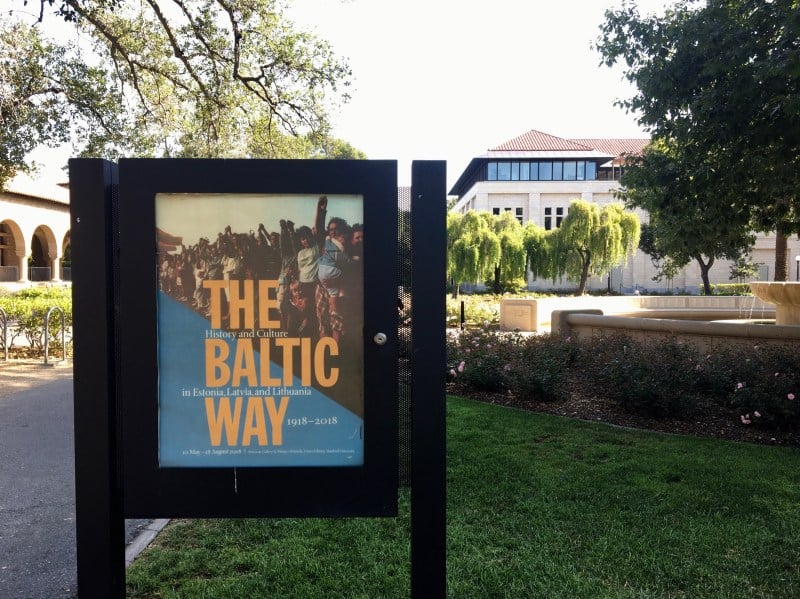Nestled in the Bing Wing of the Cecil H. Green Library lies “The Baltic Way,” an exhibition showcasing 100 years of Baltic history through artifacts and documents. The gallery, curated by Stanford and the Hoover Institution, aims to demonstrate the Baltic republics’ combined strength throughout decades of persecution, while also highlighting each country’s unique heritage and culture.
Moving clockwise around the main staircase, the exhibition starts chronologically with the aftermath of World War I and ends with the dissolution of the USSR. In the rotunda, the gallery focuses on the culture and advancement of present-day Estonia, Latvia and Lithuania.
Exhibits from letters from Baltic mothers in displaced person camps to photographs documenting the Singing Revolution in the 1980s — when Baltic people protested for their independence by singing national songs that had been forbidden by the USSR — tell the story of three countries struggling to retain their individuality amidst great oppression.
“The exhibit attempts to explain the complicated history of Estonia, Latvia and Lithuania in the 20th century, while indicating some of the prospects for these countries in the 21st,” wrote David Jacobs, the Hoover Institution Library & Archives project archivist, in a statement on one of the displays.
In the 21st century-focused display cases, the exhibit notes that while the Baltic countries are currently lacking in size and population, they make up for it in preservation of culture. All three countries continue to hold folk singing and dancing festivals, which are recognized by the United Nations Educational, Scientific and Cultural Organization (UNESCO) as Masterpieces of the Oral and Intangible Heritage of Humanity.
The exhibit also showcases the technological advancements of the Baltic countries. For example, Estonia’s “digital society” consists of e-voting, digital signatures and the ability to process documents and access health records with digital ID cards, according to the exhibit displays.
The Hoover Institution Libraries & Archives and Stanford Libraries teamed up for over a year to plan, collect items and put together the gallery. Jacobs and Liisi Esse, the Associate Curator for Estonian and Baltic Studies, worked together to co-curate “The Baltic Way.”
“As co-curators, we first had to decide the main themes for the exhibit, go through our existing Baltic collections and select items that we wanted to showcase as part of the exhibit,” Esse wrote in an email to The Daily.
After this, the curators and library exhibits staff pieced together the artifacts in a way that would tell the full story of the Baltics.
The exhibition was named after the Baltic Way protest in 1989, when millions of people joined hands to form a human chain between the Estonian, Latvian and Lithuanian capital cities. Curators and library staff believe the combined effort to protest Soviet rule demonstrates the perseverance of the small countries.
“‘The Baltic Way’ shows the incredible story of the people of these three countries who, in the face of decades-long hardships and suffering, have continued to treasure freedom and democratic values,” said Michael Keller, the Ida M. Green Librarian, in a statement to Stanford Libraries. “It is the constant yearning for freedom and the will to fight for it that have taken the Baltic states where they are today — independent countries often praised as role-models of democracy and innovation.”
So far, the gallery has received a multitude of visitors, especially during the exhibit opening on May 10, which attracted over 100 people. During the 2018 Association for the Advancement of Baltic Studies Conference in early June, hundreds of people visited “The Baltic Way.”
According to Esse, the curators are considering the installation of an online version of the exhibit by the end of the summer, yet the idea is still a work in progress. In the meantime, “The Baltic Way” will be open to visitors until Aug. 18.
Contact Sophie Kroesche at so3.james14 ‘at’ gmail.com.
